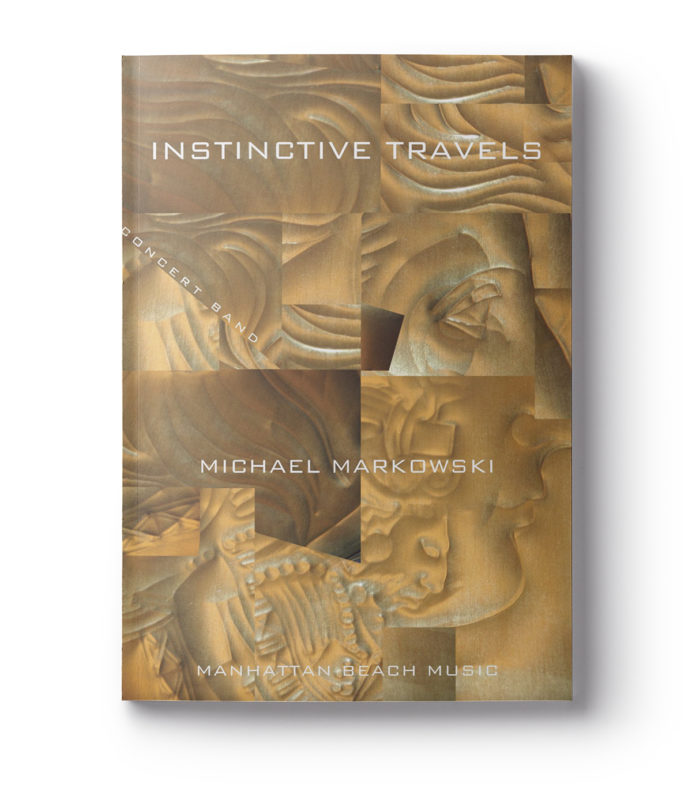Instinctive Travels
Program Note
The title, Instinctive Travels, was somewhat influenced by the 90’s hip-hop album People’s Instinctive Travels and Paths of Rhythm by the group Tribe Called Quest. One of the things I love about the hip-hop genre is an attraction to complex rhythm and metric design. While there are no traditional “hip-hop beats” in this symphonic work, the piece is incredibly infected by rhythm, particularly a primary ostinato and other small fragments.
For me, there is also something primal about rhythm that inspired a more animalistic and chaotic musical landscape. For the listener — and especially the musicians! — there is little breathing room among the tension. As the musical action reaches its peak, the brass choir recites a quotation of the hymnal All Things Bright and Beautiful. This comes as a brief release, but remains plagued by the primary rhythmic motif, stated sharply in the upper woodwinds. The evolution of the piece continues to modulate and expand, never officially reaching a traditional climax. Instead, the ending is abrupt and open (in 5ths) until the search for resolution and climactic payoff can start again, perhaps in another piece.
The melody is a 17th century tune called “Royal Oak.” In 1915, composer Martin Shaw arranged and published the “All Things Bright and Beautiful” text to that melody, and I think it’s still the most common arrangement still sung today. This hymn is only quoted twice between mm. 326 – 354. The material from 354 to the end is based off of one of the shorter themes in the piece — a theme that I will name the “call of the wild” theme — which is first stated in the horns way back in m. 27.
To better understand why I quoted this hymn, it’s interesting to know that the working title for this piece was originally, “From So Simple A Beginning,” which is a quote from the closing paragraphs of Darwin’s The Origins of Species:
“There is grandeur in this view of life, with its several powers, having been originally breathed into a few forms or into one; and that, whilst this planet has gone cycling on according to the fixed law of gravity, from so simple a beginning endless forms most beautiful and most wonderful have been, and are being, evolved.”
The piece is inherently animalistic, primal, and constantly evolving (hence the organic through-composed structure). After 6 minutes of bombastic rhythms and nonstop adrenaline, the hymn is musically refreshing, perhaps even saving — that is, until our lizard brains sharply interject again in mm. 338 – 342. For me, the hymn provides a really fascinating contextual contrast, and helps signal the climax — a metric modulation (an evolution of time and rhythm, perhaps?) — and the last musical “call of the wild” (in the augmented horn theme at m. 354).
Commissioned By
Arrowhead Union High School Wind Ensemble
Jacob Polancich
University of Wisconsin-Milwaukee Youth Wind Ensembles
Scott Corley
Publisher
Manhattan Beach Music
Instrumentation
Winds: Piccolo, Flute 1 & 2, Oboe 1 & 2, Bassoon 1 & 2, E-flat Clarinet, B-flat Clarinet 1-3, B-flat Bass Clarinet, E-flat Contrabass Clarinet, Alto Saxophone 1 & 2, Tenor Saxophone, Baritone Saxophone
Brass: B-flat Trumpet 1-4, Horn 1-4, Trombone 1-2, Bass Trombone, Euphonium, Tuba
Strings: String Bass
Keyboards: Piano
Percussion: Timpani (and Chimes, shared with P1); P1) Chimes (shared with Timpani), Marimba, Vibraphone, Glockenspiel; P2) Three Suspended Cymbals (large, medium, small), Suspended China Cymbal; P3) Five Temple Blocks, Snare Drum, Splash Cymbal; P4) Four Tom-Toms, Triangle (large), Wood Block, FX Cymbal (special effects cymbal at player’s discretion); P5) Bass Drum
Errata
No known errata.
Year Completed
2009

